Antiquities: Philips Velo 1, tech enthusiast nightmare
In English, there is such a thing as "early adopter". I'm not sure if it can be adequately translated into Russian, it only comes to mind that the saying “Hurry up - make you laugh people”. Early adopter is a technology enthusiast who wants to try them out as soon as possible, without waiting for the solution of the many inevitable problems and shoals at the start of production. In 2007, such enthusiasts brought the first iPhones from the US to the operator and unattached. Now they are buying smartphones with a flexible screen, learning 3D printing and VR technologies.
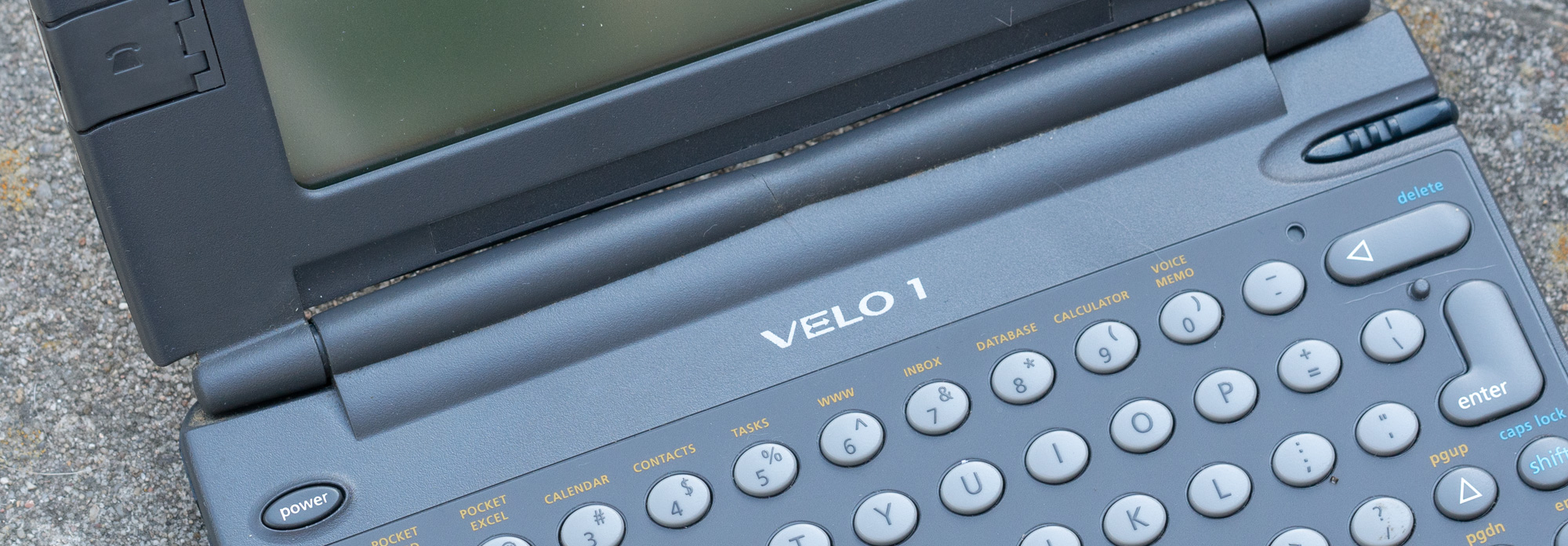
In general, they are involved in beta testing of products that actually appear on sale, as ready-made and proven devices. But no. First, you are faced with a high percentage of failures and, if not lucky, change your purchase under warranty three times. Then you try to circumvent the unrecoverable flaws: either the battery is eaten in an hour, then the applications are buggy, then something else. A year later, the second generation of devices comes out, and changes overnight make the expensive pinnacle of progress into an outdated, unsuitable buggy division of the past. But you are not complaining. That is, complaining, but still happy: after all, almost no one has such a device, and you have one.
In 1996, Microsoft begins a massive attack on the market of wearable devices. In 1997, the first generation devices come out - keyboard PDAs. Among them, one stands out both in terms of performance and functionality, and when it is possible to upgrade. The pocket computer Philips Velo 1 did not escape the curse of the first mover, it became extremely outdated, broke a lot and was deservedly forgotten. For a number of personal reasons, I bought this PDA, and decided to test for myself what was a mobile Windows twenty-two years ago.
I keep the diary of the collector of old pieces of iron in real time in the Telegram .
')
The pinnacle of the development of a handheld computer can be considered a modern smartphone: only in the second decade of the 21st century, they began to be sold in hundreds of millions of copies. In the nineties, the cell phone and the PDA were not yet merged into one device, and at best it was possible to connect one to the other. CCPs were sold not by millions of pieces, at the best - by hundreds of thousands a year.

In 1997, two devices were truly outstanding. This is the Psion Series 5, a PDA with a convenient keyboard, a fast native operating system EPOC32 and smart tools for business management (contacts, calendar, task management). And the Palm PDA (at that time known as the PalmPilot) is the first successful implementation of a device without a keyboard, with text input using a stylus. A device with obviously limited capabilities, a prefix to a computer with a minimum of memory (2 megabytes), cheap and well performing a limited set of tasks. The photo shows the earliest Palm PDA in my collection, the budget model IIIe 1999, which differs little from the 1997 models.
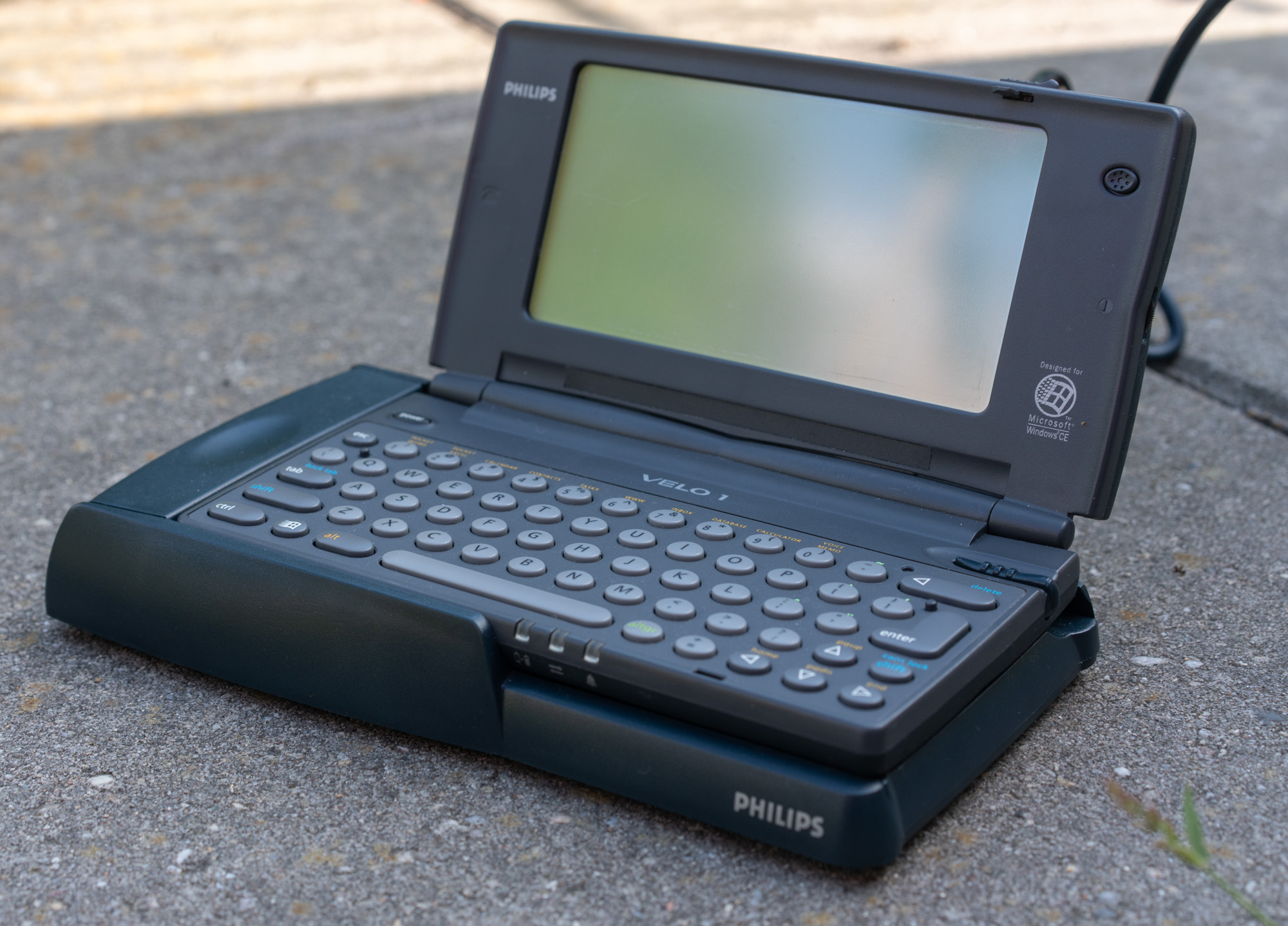
According to Microsoft, which at that time held a dominant position in the desktop OS market, the handheld computer should be almost the same as the large one. Hence the requirements for device manufacturers: a large screen with a resolution of 480x240, serial and infrared ports, a PCMCIA slot (!), A full-fledged keyboard. User experience Windows 95 was recreated almost completely: the same desktop with icons, taskbar, start button, explorer, clock in the corner.
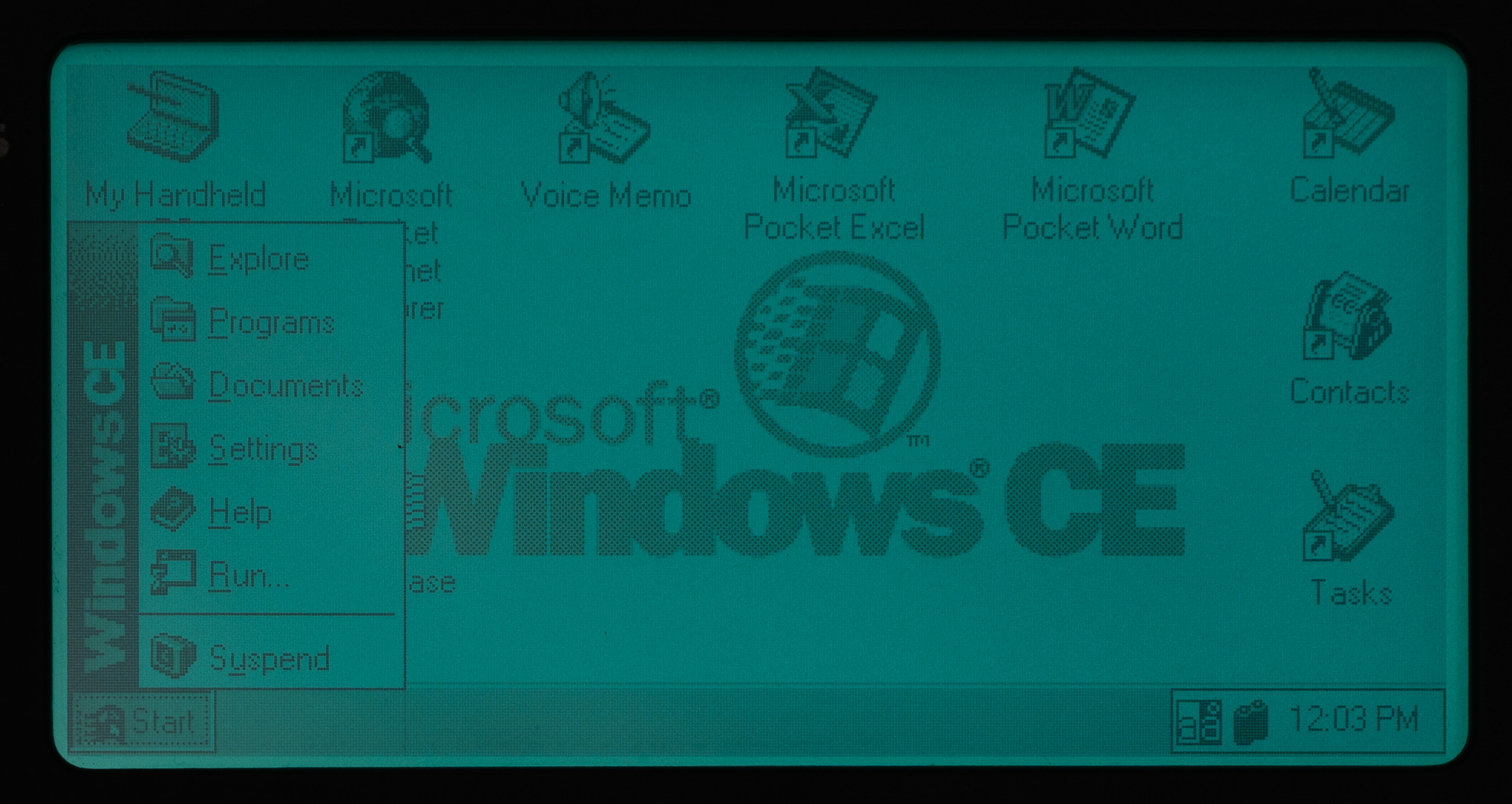
According to eyewitnesses, in Palm (in the late nineties - the undisputed market leader), and in Psion, they feared Microsoft would enter the market. With her marketing budgets, her ability to find production partners, she could easily bankrupt relatively small competitors. Both companies, responding to the threat, began to license their operating systems to other companies. In both cases, the licensing process violated the streamlined interaction between software and hardware developers within companies, but this is a topic for another article. Microsoft introduced Windows CE 1.0 in the fall of 1996, promising bombing to portable fans and incredible versatility. In fact, it did not work out very well: all device manufacturers on the Windows CE platform could collectively take up only 25% of the pocket computer market by the end of 1998.
But it was a competition in the microscopic market. If in 1997 you chose a new device for, let's say, work with data, you had a choice between Palm, devices on the Microsoft platform, you could buy Psion. And it was possible to buy an inexpensive electronic organizer or even a cheap paper notepad - and the last option was chosen by most people in a situation where not everyone could afford a regular computer. The CCP is a choice of enthusiasts who are ready to pay a lot for progress with incomprehensible prospects. However, let's not guess, but look at the device. How is it at all?

Yes, good! At first I bought the device without accessories, only the docking station was included, without which it is impossible to synchronize the PDA with the proprietary port. But this copy was almost like new. The characteristics of the PDA are as follows:
Microsoft failed to force manufacturers to strictly comply with the specifications. For example, HP decided to single out its PDA at the expense of a larger screen (600 points instead of 480 horizontally). Philips refused to embed a PCMCIA slot in Velo 1, and instead transferred it to a plug-in module from below. At the expense of the processor more powerful and, perhaps, faster memory, Velo 1 became the winner of the PC Magazine test in early 1997. True, then the study did not get all the devices of the first wave.

Another unique feature of the Philips PDA was the built-in modem. In earlier versions, near the screen was a tricky connector, where the telephone cable was directly inserted. If you have a phone, you could go online or connect to a BBS without additional devices. Other manufacturers relied on the installation of the modem by the user in the PCMCIA slot, or they sold adapters for connecting a mobile phone.

From the Psion of the fifth series, the Velo 1 differs primarily in the "calculator" keyboard. It is not possible to quickly type text on these rubber buttons, but the layout is fully consistent with that of a laptop. Because of this, for example, when typing in Cyrillic, there is no problem locating a part of the letters in strange and unexpected places.
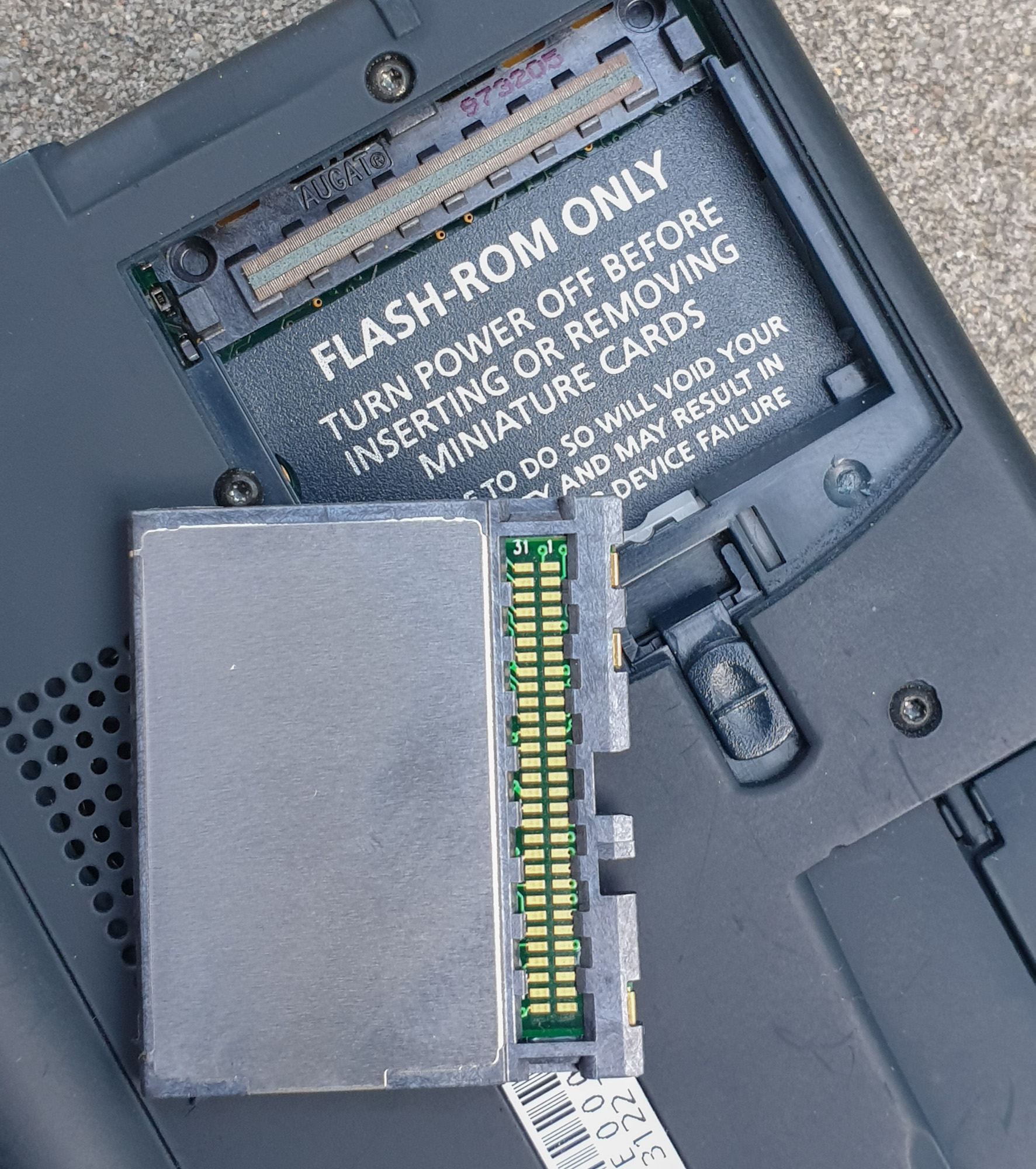
Rejecting the built-in PCMCIA, Philips provided the Velo 1 with two slots for expansion cards: one was designed to increase the amount of RAM, a non-volatile USB stick could be inserted into the second. The standard for both types of cards was the same - a little-known now Miniature Card , a failed competitor to Compact Flash and SD / MMC cards.

When I first met, it was frankly not clear what the problem was with the devices, why did they sell relatively poorly? Excellent copies of desktop MS Word and Excel, email client, built-in browser (which was not either Psion or Palm, it was required to buy separately). Solitaire, finally! In the late 90s, Palm tried to counteract the marketing efforts of Microsoft. When meeting with partners and industry experts, they compare devices on a practical task, for example, how quickly can you find a number in the phone book? Where Palm needs a couple of strokes with the stylus, Microsoft, through a heavyweight interface, requires a whole special operation.
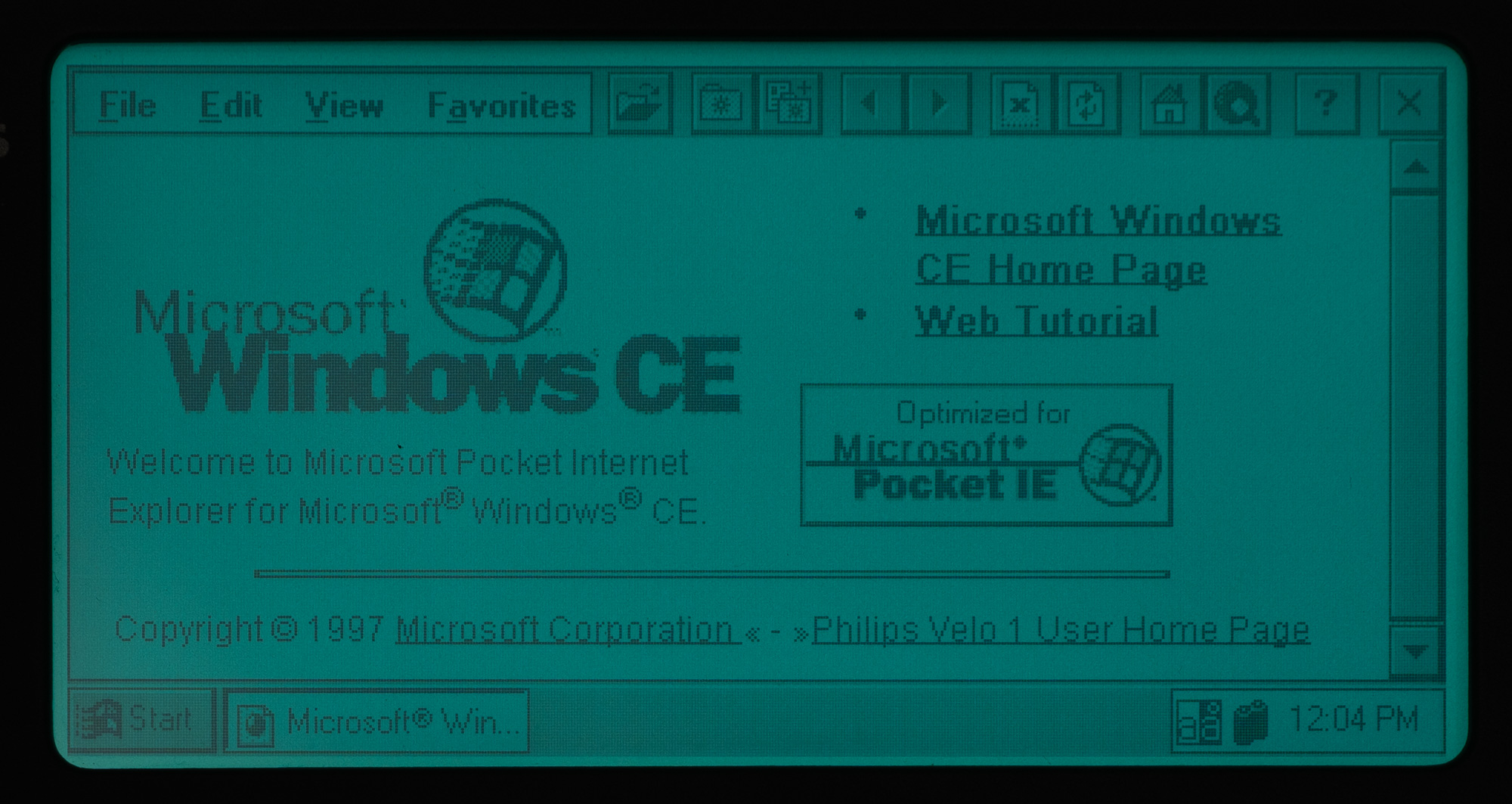
Philips Velo 1 is interesting just for its versatility: almost like a laptop, only more compact. Direct Internet connection, the ability to work with mail and the web. But do not forget that we are talking about a light-blind monochrome screen, a memory of only 4 megabytes, and it is used both for the work of programs and for data storage. In theory, it seems that such a device could become almost the main computer. In practice, well, not really.
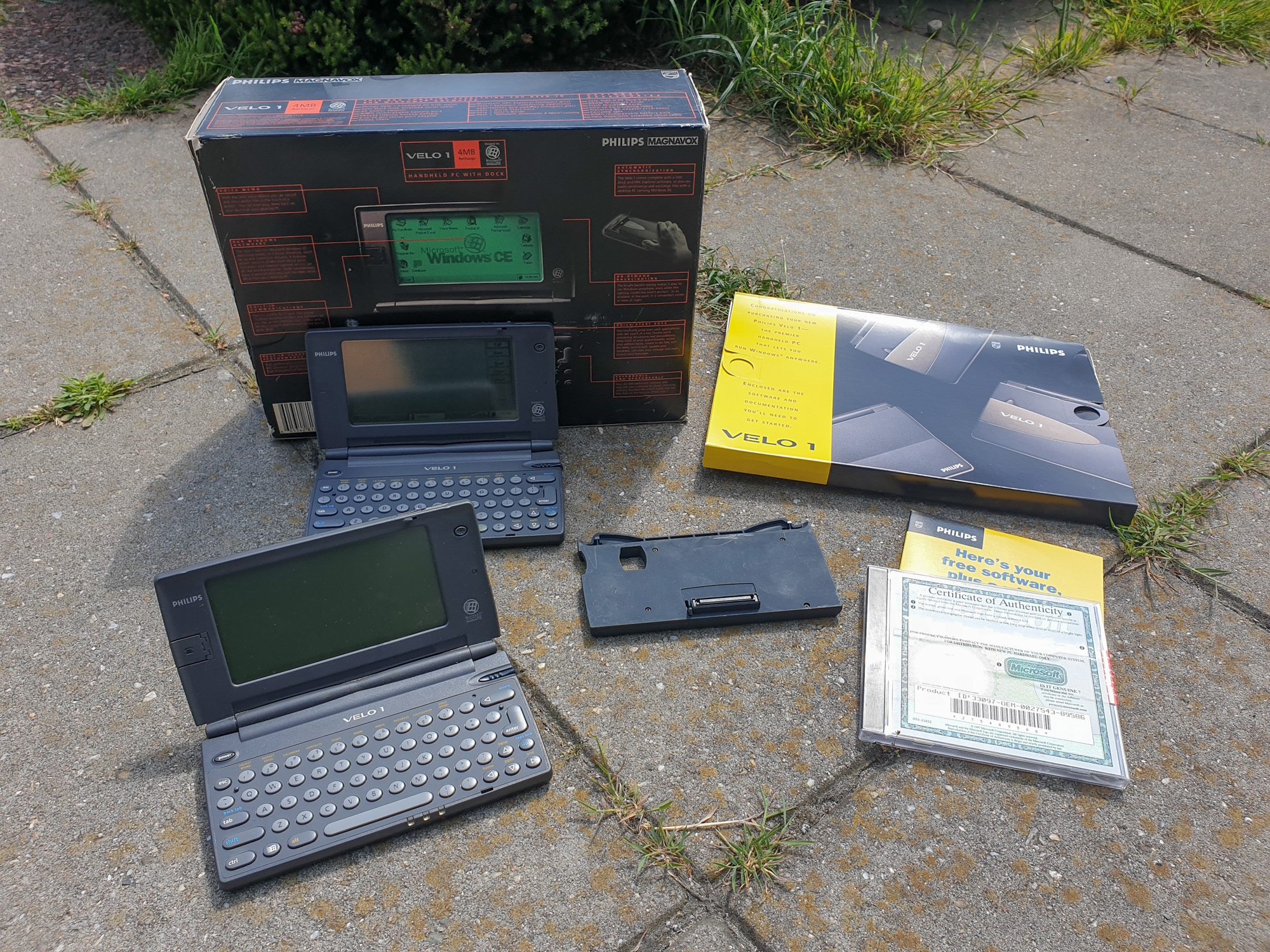
A couple of weeks after buying a vintage PDA, I have a collector's luck: I order an inexpensive second device with a full set of accessories, in a box, but spoiled by a leaking battery. He had to be disassembled and cleaned of oxides, otherwise he switched on through time. It's time to talk about the hardware reliability of these early PDAs.
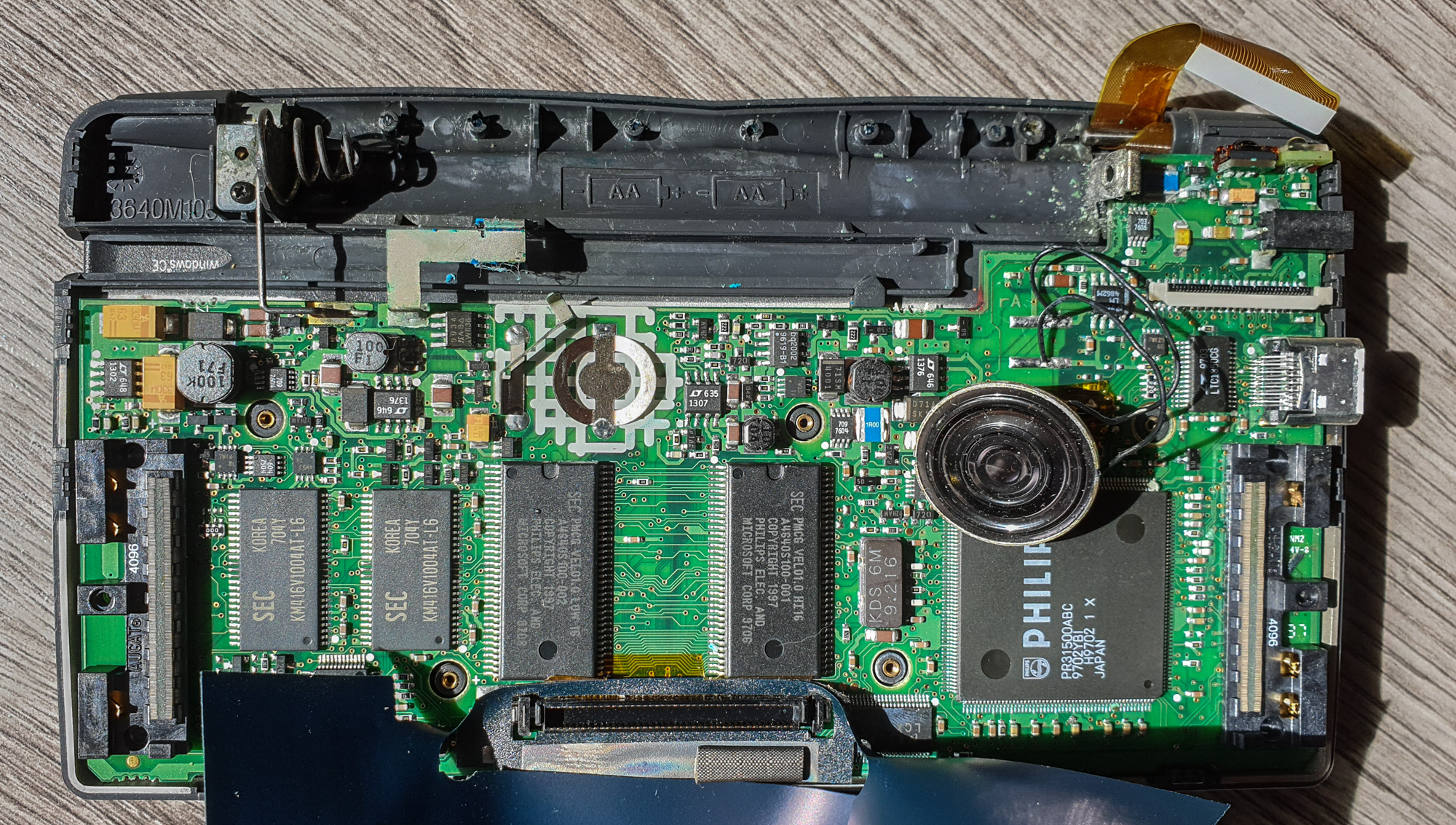
I recommend to look at this archive copy of the Philips Velo 1 owner site. He describes his sufferings with the device in some detail, not forgetting, however, to praise him for the new features and convenience. Several times he had to change the PDA under warranty because of the “dangling” screen. The metal display mount came out unreliable and flew out of the plastic part of the case. Later this problem was solved, but another one appeared - with time the whole mechanism became loose. Therefore, my Velo 1, the one that is newer, is not fixed at all in the open position, fully unfolding. Judging by the reviews on YouTube, this is a frequent problem. But that's not all: there were both touchscreen hangs and data loss. The “regular” feature was the modem or PCMCIA-module operation mode - it ate up the battery in minutes instead of 10-12 hours.
The most important artifact of the second Velo 1 was the upgrade kit to Windows CE 2.0. Philips Velo 1 entered the wide sale relatively late - in September 1997. Already in November of the same year, Microsoft introduced an update. In the new version of the OS (more about it - here ), there is support for color screens, TrueType fonts, a portable version of Microsoft Powerpoint has been added, support for PCMCIA cards has been expanded. For the first time, support for keyboardless PDAs appeared: they were called the Palm PC, and after a sharp protest, Palm was renamed Palm-size. The devices of the first generation are outdated literally in six months, and not all could be updated to the new version. With new features, system requirements have increased dramatically: now two megabytes of RAM was not enough.
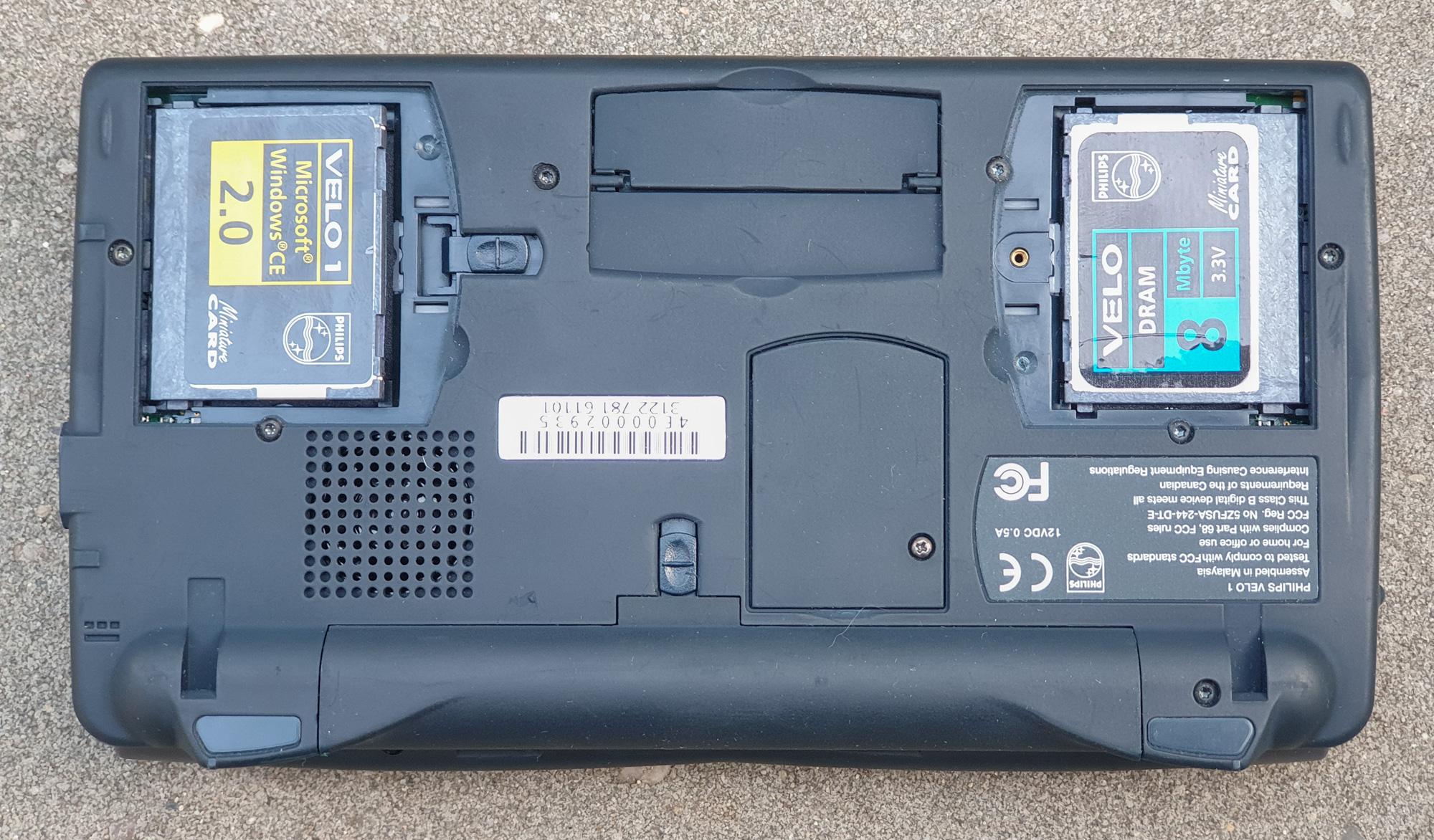
And how much is enough? It seems that at first the answer to this question was not known to Philips itself. Velo 1 owners have been advised to buy a 4 MB RAM expansion card. After many have done so, it turned out that an 8 megabyte card is required (12 megabytes, taking into account the soldered on the board). As a result, the upgrade kit for Windows CE 2.0 was sold for $ 99 and included two expansion cards: an 8 megabyte RAM, and a ROM from the OS itself. After a rather non-trivial shamanism (an external power supply is required, which I did not have, and it was necessary to insert and remove batteries in a sly way to enable booting from an external ROM card), you received an updated operating system. But not a color screen.

Upgrading to Windows CE 2.0 made it possible to go to the final stage of acquaintance with the PDA: installing the cracker. Devices on WinCE 1.0 have so little lived on the market that it is quite difficult to find compatible software for them in 2019. For PDAs on Windows CE 2.0 and higher, on the MakTsentr company site, there is still a free cracker (I would like to thank them once again for keeping the archive).
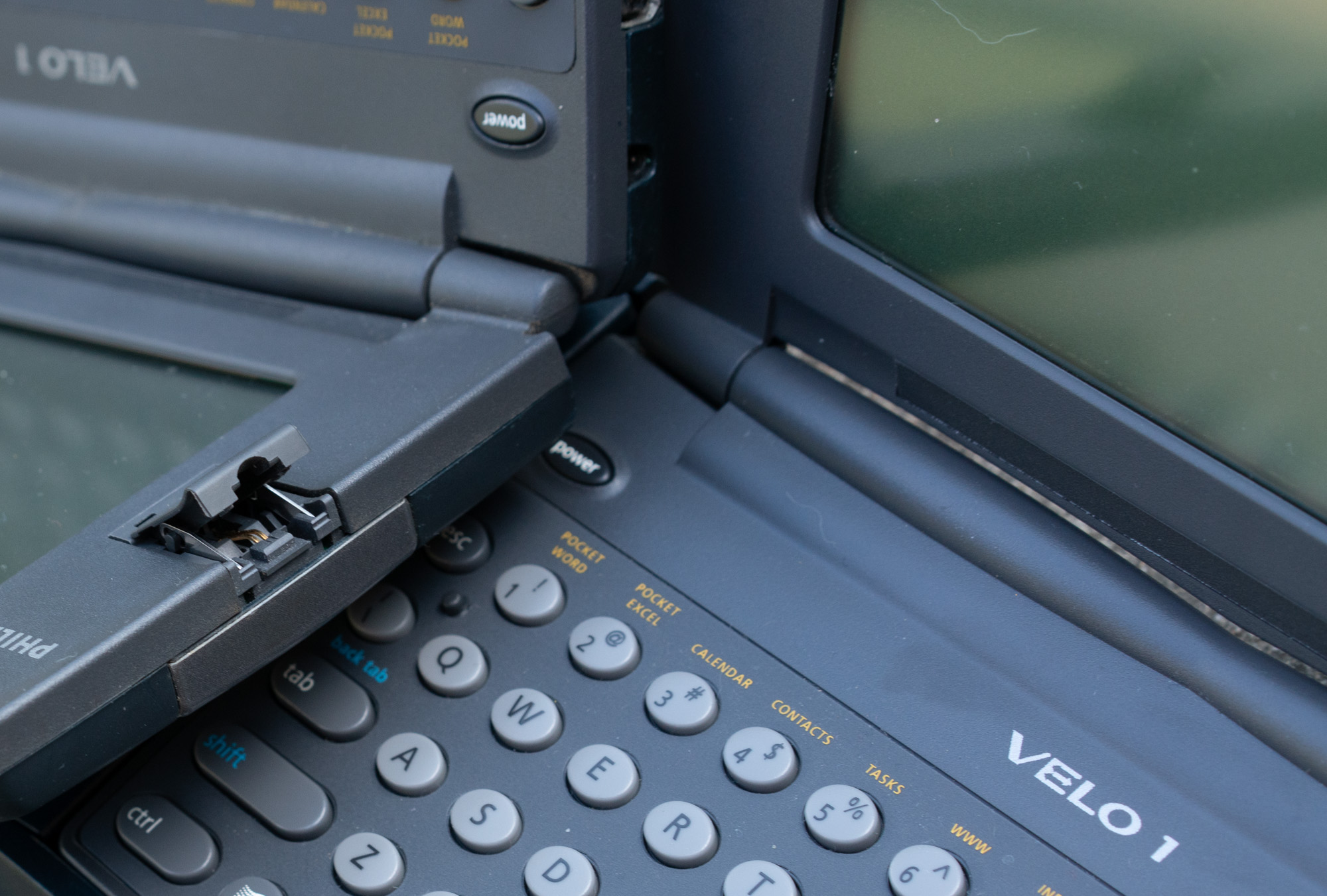
To synchronize with a computer and install the software, you need the H / PC Explorer program. In 1999, she received the usual name Microsoft Activesync. The third version of this program, the last one with support for Windows 98, was already installed by me for experiments with the iPaq hx4700 . She earned no problems with the old Velo 1, but before that I had to read the instructions and “create a connection” in the settings of the PDA itself (why did they do that ?!). Since the connection goes through the serial port, synchronization is extremely slow. But there are no such problems with the coding of documents in Cyrillic, as on devices based on Palm OS .
Windows CE in the first version, and in the second, works on Velo 1 rather slowly. A delay of a few seconds when programs start is the norm. By comparison, the Palm OS of those years was incredibly brisk, and the well-optimized Psion on EPOC32 gave this pleasant effect of quick response to user commands. Windows CE feels best on the latest generation of keyboard handhelds - with processors under 200 megahertz and 64 megabytes of RAM. Velo 1 - a typical pioneer, which laid the foundations of a universal mobile OS. He is capable of much in theory, but he copes with the specific functions necessary for the business a little worse than the competitors that existed at that time. But not worse than an order of magnitude: now all pocket computers of the nineties are perceived as a mobile Middle Ages.

I plan to continue exploring the possibilities of Velo 1: connect to the Internet via a modem, and maybe even via Ethernet, select the appropriate software. I want to make him a museum copy, suitable for something useful, albeit by the standards of twenty years ago. Otherwise, the entire range of possibilities is only one constant solitaire "Klondike". In the meantime, I put a tick in front of the last item on the list of 15-year-old women from 1997. Then I could dream about anything, since I still could not afford anything. But for some reason most of all I wanted these achievements of science and technology: a laptop , a multifunctional pocket computer, a minidisk player, a digital camera . The total cost of the artifacts in the photo is about $ 3,700 then almost six thousand in modern money. Dreams come true, you just have to wait a bit!

In general, they are involved in beta testing of products that actually appear on sale, as ready-made and proven devices. But no. First, you are faced with a high percentage of failures and, if not lucky, change your purchase under warranty three times. Then you try to circumvent the unrecoverable flaws: either the battery is eaten in an hour, then the applications are buggy, then something else. A year later, the second generation of devices comes out, and changes overnight make the expensive pinnacle of progress into an outdated, unsuitable buggy division of the past. But you are not complaining. That is, complaining, but still happy: after all, almost no one has such a device, and you have one.
In 1996, Microsoft begins a massive attack on the market of wearable devices. In 1997, the first generation devices come out - keyboard PDAs. Among them, one stands out both in terms of performance and functionality, and when it is possible to upgrade. The pocket computer Philips Velo 1 did not escape the curse of the first mover, it became extremely outdated, broke a lot and was deservedly forgotten. For a number of personal reasons, I bought this PDA, and decided to test for myself what was a mobile Windows twenty-two years ago.
I keep the diary of the collector of old pieces of iron in real time in the Telegram .
')
Turn on the time machine
The pinnacle of the development of a handheld computer can be considered a modern smartphone: only in the second decade of the 21st century, they began to be sold in hundreds of millions of copies. In the nineties, the cell phone and the PDA were not yet merged into one device, and at best it was possible to connect one to the other. CCPs were sold not by millions of pieces, at the best - by hundreds of thousands a year.

In 1997, two devices were truly outstanding. This is the Psion Series 5, a PDA with a convenient keyboard, a fast native operating system EPOC32 and smart tools for business management (contacts, calendar, task management). And the Palm PDA (at that time known as the PalmPilot) is the first successful implementation of a device without a keyboard, with text input using a stylus. A device with obviously limited capabilities, a prefix to a computer with a minimum of memory (2 megabytes), cheap and well performing a limited set of tasks. The photo shows the earliest Palm PDA in my collection, the budget model IIIe 1999, which differs little from the 1997 models.

According to Microsoft, which at that time held a dominant position in the desktop OS market, the handheld computer should be almost the same as the large one. Hence the requirements for device manufacturers: a large screen with a resolution of 480x240, serial and infrared ports, a PCMCIA slot (!), A full-fledged keyboard. User experience Windows 95 was recreated almost completely: the same desktop with icons, taskbar, start button, explorer, clock in the corner.

According to eyewitnesses, in Palm (in the late nineties - the undisputed market leader), and in Psion, they feared Microsoft would enter the market. With her marketing budgets, her ability to find production partners, she could easily bankrupt relatively small competitors. Both companies, responding to the threat, began to license their operating systems to other companies. In both cases, the licensing process violated the streamlined interaction between software and hardware developers within companies, but this is a topic for another article. Microsoft introduced Windows CE 1.0 in the fall of 1996, promising bombing to portable fans and incredible versatility. In fact, it did not work out very well: all device manufacturers on the Windows CE platform could collectively take up only 25% of the pocket computer market by the end of 1998.
But it was a competition in the microscopic market. If in 1997 you chose a new device for, let's say, work with data, you had a choice between Palm, devices on the Microsoft platform, you could buy Psion. And it was possible to buy an inexpensive electronic organizer or even a cheap paper notepad - and the last option was chosen by most people in a situation where not everyone could afford a regular computer. The CCP is a choice of enthusiasts who are ready to pay a lot for progress with incomprehensible prospects. However, let's not guess, but look at the device. How is it at all?

Yes, good! At first I bought the device without accessories, only the docking station was included, without which it is impossible to synchronize the PDA with the proprietary port. But this copy was almost like new. The characteristics of the PDA are as follows:
- Processor: Philips MP3910, 36.8 MHz, MIPS architecture
- Memory: 4 megabytes of RAM, 8 megabytes of ROM
- Screen: 5.1 inches, backlit monochrome, touchscreen, 4 shades of gray, 480x240 pixels
- Interfaces and communication: RS232, IrDA, RJ-11 for a built-in modem for 19200 b / c, two slots for expansion cards, a V-Module slot for an adapter for PCMCIA cards
- Battery: 2 AA cells or a battery, CR2032 cell for storing data during battery replacement, up to 12 hours of battery life
- Dimensions: 172x95x32 mm
- Weight: 374 grams
- Price at the start of sales: $ 700 ($ 1,100 with inflation)
Microsoft failed to force manufacturers to strictly comply with the specifications. For example, HP decided to single out its PDA at the expense of a larger screen (600 points instead of 480 horizontally). Philips refused to embed a PCMCIA slot in Velo 1, and instead transferred it to a plug-in module from below. At the expense of the processor more powerful and, perhaps, faster memory, Velo 1 became the winner of the PC Magazine test in early 1997. True, then the study did not get all the devices of the first wave.

Another unique feature of the Philips PDA was the built-in modem. In earlier versions, near the screen was a tricky connector, where the telephone cable was directly inserted. If you have a phone, you could go online or connect to a BBS without additional devices. Other manufacturers relied on the installation of the modem by the user in the PCMCIA slot, or they sold adapters for connecting a mobile phone.

From the Psion of the fifth series, the Velo 1 differs primarily in the "calculator" keyboard. It is not possible to quickly type text on these rubber buttons, but the layout is fully consistent with that of a laptop. Because of this, for example, when typing in Cyrillic, there is no problem locating a part of the letters in strange and unexpected places.

Rejecting the built-in PCMCIA, Philips provided the Velo 1 with two slots for expansion cards: one was designed to increase the amount of RAM, a non-volatile USB stick could be inserted into the second. The standard for both types of cards was the same - a little-known now Miniature Card , a failed competitor to Compact Flash and SD / MMC cards.

When I first met, it was frankly not clear what the problem was with the devices, why did they sell relatively poorly? Excellent copies of desktop MS Word and Excel, email client, built-in browser (which was not either Psion or Palm, it was required to buy separately). Solitaire, finally! In the late 90s, Palm tried to counteract the marketing efforts of Microsoft. When meeting with partners and industry experts, they compare devices on a practical task, for example, how quickly can you find a number in the phone book? Where Palm needs a couple of strokes with the stylus, Microsoft, through a heavyweight interface, requires a whole special operation.

Philips Velo 1 is interesting just for its versatility: almost like a laptop, only more compact. Direct Internet connection, the ability to work with mail and the web. But do not forget that we are talking about a light-blind monochrome screen, a memory of only 4 megabytes, and it is used both for the work of programs and for data storage. In theory, it seems that such a device could become almost the main computer. In practice, well, not really.

A couple of weeks after buying a vintage PDA, I have a collector's luck: I order an inexpensive second device with a full set of accessories, in a box, but spoiled by a leaking battery. He had to be disassembled and cleaned of oxides, otherwise he switched on through time. It's time to talk about the hardware reliability of these early PDAs.

I recommend to look at this archive copy of the Philips Velo 1 owner site. He describes his sufferings with the device in some detail, not forgetting, however, to praise him for the new features and convenience. Several times he had to change the PDA under warranty because of the “dangling” screen. The metal display mount came out unreliable and flew out of the plastic part of the case. Later this problem was solved, but another one appeared - with time the whole mechanism became loose. Therefore, my Velo 1, the one that is newer, is not fixed at all in the open position, fully unfolding. Judging by the reviews on YouTube, this is a frequent problem. But that's not all: there were both touchscreen hangs and data loss. The “regular” feature was the modem or PCMCIA-module operation mode - it ate up the battery in minutes instead of 10-12 hours.
Windows CE 2.0
The most important artifact of the second Velo 1 was the upgrade kit to Windows CE 2.0. Philips Velo 1 entered the wide sale relatively late - in September 1997. Already in November of the same year, Microsoft introduced an update. In the new version of the OS (more about it - here ), there is support for color screens, TrueType fonts, a portable version of Microsoft Powerpoint has been added, support for PCMCIA cards has been expanded. For the first time, support for keyboardless PDAs appeared: they were called the Palm PC, and after a sharp protest, Palm was renamed Palm-size. The devices of the first generation are outdated literally in six months, and not all could be updated to the new version. With new features, system requirements have increased dramatically: now two megabytes of RAM was not enough.

And how much is enough? It seems that at first the answer to this question was not known to Philips itself. Velo 1 owners have been advised to buy a 4 MB RAM expansion card. After many have done so, it turned out that an 8 megabyte card is required (12 megabytes, taking into account the soldered on the board). As a result, the upgrade kit for Windows CE 2.0 was sold for $ 99 and included two expansion cards: an 8 megabyte RAM, and a ROM from the OS itself. After a rather non-trivial shamanism (an external power supply is required, which I did not have, and it was necessary to insert and remove batteries in a sly way to enable booting from an external ROM card), you received an updated operating system. But not a color screen.

Upgrading to Windows CE 2.0 made it possible to go to the final stage of acquaintance with the PDA: installing the cracker. Devices on WinCE 1.0 have so little lived on the market that it is quite difficult to find compatible software for them in 2019. For PDAs on Windows CE 2.0 and higher, on the MakTsentr company site, there is still a free cracker (I would like to thank them once again for keeping the archive).

To synchronize with a computer and install the software, you need the H / PC Explorer program. In 1999, she received the usual name Microsoft Activesync. The third version of this program, the last one with support for Windows 98, was already installed by me for experiments with the iPaq hx4700 . She earned no problems with the old Velo 1, but before that I had to read the instructions and “create a connection” in the settings of the PDA itself (why did they do that ?!). Since the connection goes through the serial port, synchronization is extremely slow. But there are no such problems with the coding of documents in Cyrillic, as on devices based on Palm OS .
Windows CE in the first version, and in the second, works on Velo 1 rather slowly. A delay of a few seconds when programs start is the norm. By comparison, the Palm OS of those years was incredibly brisk, and the well-optimized Psion on EPOC32 gave this pleasant effect of quick response to user commands. Windows CE feels best on the latest generation of keyboard handhelds - with processors under 200 megahertz and 64 megabytes of RAM. Velo 1 - a typical pioneer, which laid the foundations of a universal mobile OS. He is capable of much in theory, but he copes with the specific functions necessary for the business a little worse than the competitors that existed at that time. But not worse than an order of magnitude: now all pocket computers of the nineties are perceived as a mobile Middle Ages.

I plan to continue exploring the possibilities of Velo 1: connect to the Internet via a modem, and maybe even via Ethernet, select the appropriate software. I want to make him a museum copy, suitable for something useful, albeit by the standards of twenty years ago. Otherwise, the entire range of possibilities is only one constant solitaire "Klondike". In the meantime, I put a tick in front of the last item on the list of 15-year-old women from 1997. Then I could dream about anything, since I still could not afford anything. But for some reason most of all I wanted these achievements of science and technology: a laptop , a multifunctional pocket computer, a minidisk player, a digital camera . The total cost of the artifacts in the photo is about $ 3,700 then almost six thousand in modern money. Dreams come true, you just have to wait a bit!
Source: https://habr.com/ru/post/455132/
All Articles